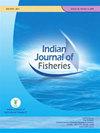对印度东北部特有的高价值中型鲤鱼 Osteobrama belangeri(Pengba)的耐热极限进行评估
IF 0.3
4区 农林科学
Q4 FISHERIES
引用次数: 0
摘要
对印度东北部丘陵生态系统特有的高价值中鲤 Osteobrama belangeri(Pengba)的临界最高温度(CTmax)、致死最高温度(LTmax)、厣呼吸速率(ORR - 每分钟厣的运动)、温度商数(Q10)和应力指标进行了研究,目的是了解其水产养殖潜力以及在温度升高时的管理要求。将鱼(7.82±0.35 厘米/4.64±0.36 克)分别在 20、25 和 30°C 的保温箱中(每箱 10 条鱼)驯化 30 天。随着驯化温度从 20°C 升至 30°C,鱼的 CTmax、LTmax 和 ORR 显著增加。回归分析表明,驯化温度与 CTmax(y = 0.22x + 33.55,R² = 0.97)和 LTmax(y = 0.27x + 32.86,R² = 0.99)之间存在很强的正相关性。在 CTmax 和 LTmax 终点采集鱼血样,并分析血清碱性磷酸酶 (ALP) 活性。结果表明,鱼类在适应温度为 30°C 时承受的压力最大(ALP:38.7 U l-1),其次是 25°C(35.6 U l-1)和 20°C(31.7 U l-1)。结果表明,水温升至 30°C 以上会损害白龙鱼的生理机能,进而影响其繁殖能力。因此,在这种情况下,有必要进行适当的管理和额外的照料,以保护它们免遭灭绝。关键词:临界最高温度;致命最高温度;Osteobrama belangeri;热极限;温度商数本文章由计算机程序翻译,如有差异,请以英文原文为准。
Assessment of Osteobrama belangeri (Pengba), a high-value medium carp endemic to North-east India for thermal tolerance limits
Critical thermal maxima (CTmax), lethal temperature maxima (LTmax), opercular respirationrate (ORR - movement of operculum per minute), temperature quotient (Q10) and stressmarkers of Osteobrama belangeri (Pengba), a high-value medium carp endemic tohilly ecosystems of North-east India, were examined with the aim of understanding itsaquaculture potential and management requirements in the event of a temperature rise.Fish (7.82±0.35 cm/4.64±0.36 g) were acclimatised at 20, 25 and 30°C in insulated tanks(10 fish per tank) for 30 days. They were then exposed to a water temperature increase(@ 1°C day-1) using a locally-fabricated thermostat and assessed for CTmax, LTmax and ORR.As the acclimation temperature increased from 20 to 30°C, CTmax, LTmax and ORR of thefish significantly increased. Regression analysis indicated a strong positive correlationbetween acclimation temperatures and CTmax (y = 0.22x + 33.55, R² = 0.97) and LTmax(y = 0.27x + 32.86, R² = 0.99). Fish blood samples were collected at the endpoints ofCTmax and LTmax and analysed for serum alkaline phosphatase (ALP) activity. The resultsindicated that the fish experienced maximum stress at an acclimation temperature of 30°C(ALP: 38.7 U l-1), followed by 25°C (35.6 U l-1) and 20°C (31.7 U l-1). The results suggestedthat a water temperature increase above 30°C can impair the physiology of O. belangeri andconsequently, their reproductive competence. Therefore, in such events, proper managementand additional care are necessary to protect them from extinction. Keywords:Critical thermal maxima, Lethal temperaturemaxima, Osteobrama belangeri, Thermal limit,Temperature quotient
求助全文
通过发布文献求助,成功后即可免费获取论文全文。
去求助
来源期刊

Indian Journal of Fisheries
FISHERIES-
CiteScore
0.90
自引率
20.00%
发文量
0
审稿时长
6-12 weeks
期刊介绍:
Indian Journal of Fisheries is published quarterly by the Indian Council of Agricultural Research (ICAR), New Delhi. Original contributions in the field of Fish and fisheries science are considered for publication in the Journal. The material submitted must be unpublished and not under consideration for publication elsewhere.
Papers based on research which kills or damages any species, regarded as thratened/ endangered by IUCN crieteria or is as such listed in the Red Data Book appropriate to the geographic area concerned, will not be accepted by the Journal, unless the work has clear conservation objectives.
 求助内容:
求助内容: 应助结果提醒方式:
应助结果提醒方式:


